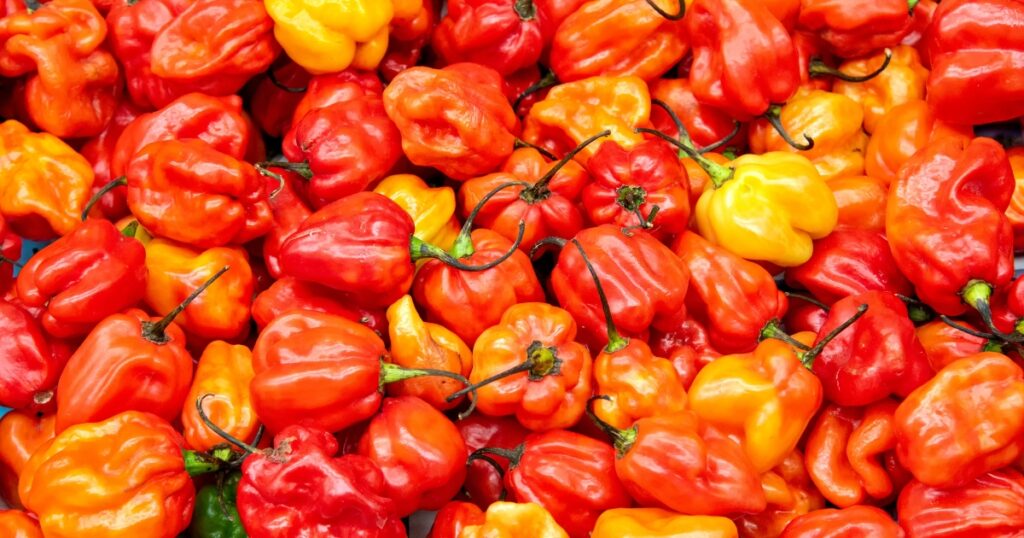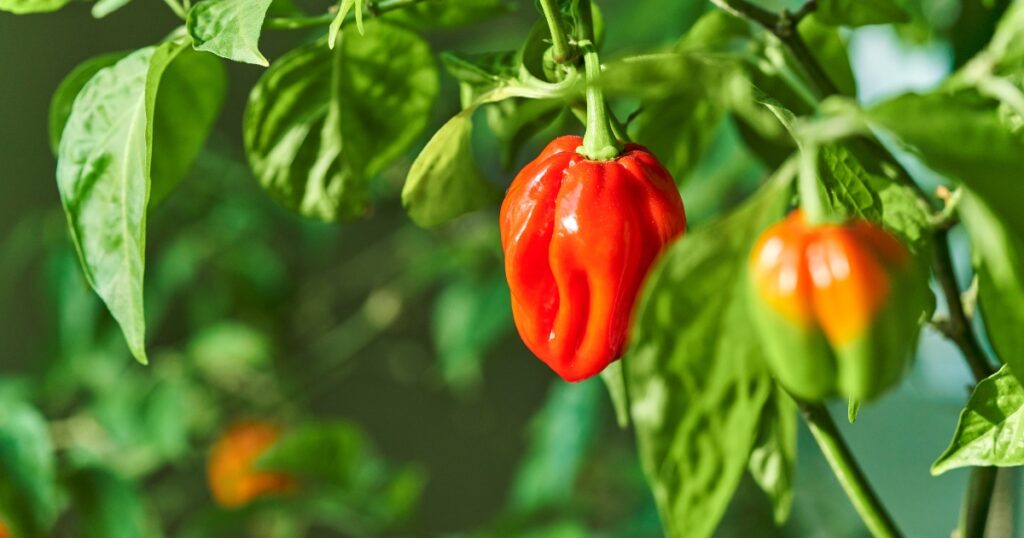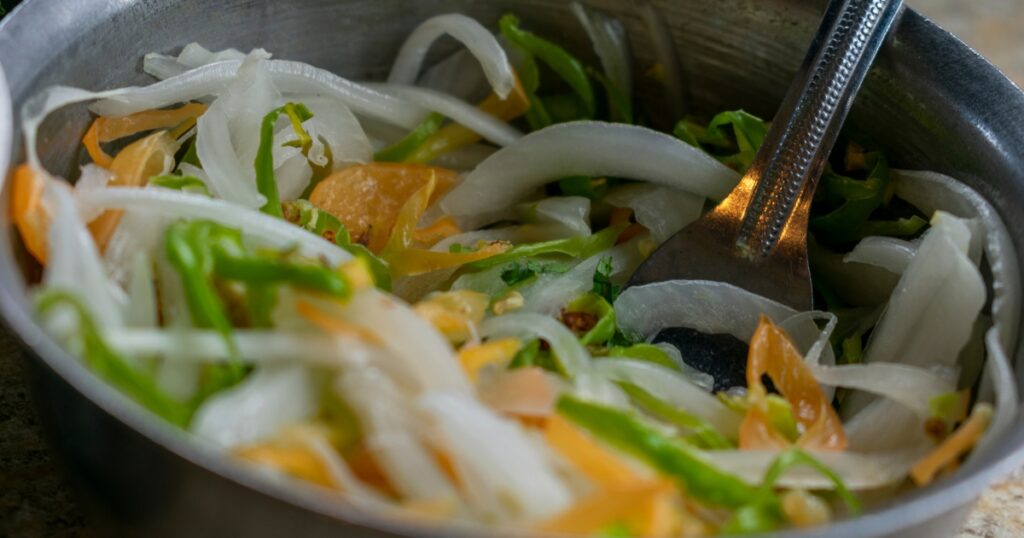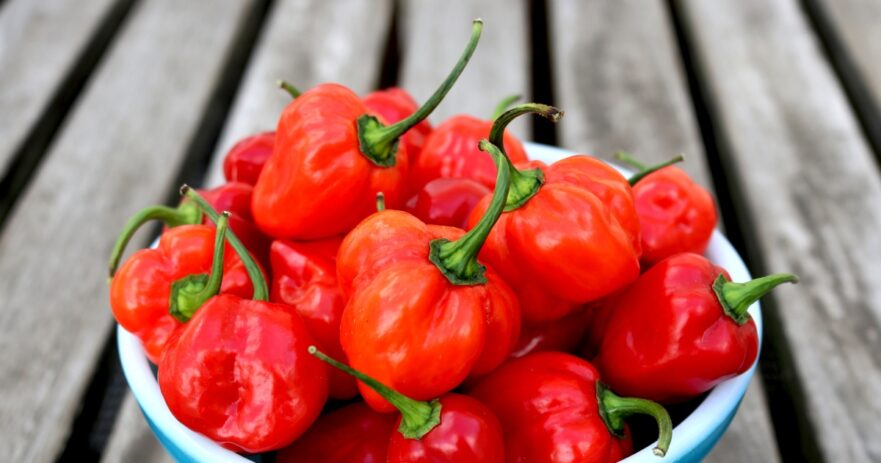In this article about habanero:
🗺️ Origin and history | 🌶️ Uses | ✨ Appearance and taste | 🌶️ Types | 🧑🌾 Growing – gardening | 👨🍳 Cooking – recipes | 🛒 Where to buy | 🫙 How to store | 👨⚕️ Health benefits | 🌶️ Alternatives and substitutes | ❓ Frequently asked questions
What is habanero?
Habanero peppers are a fiery and flavorful chili pepper variety widely celebrated in various cuisines, particularly those of Mexico and the Caribbean. Their intense heat and fruity, citrusy, tropical taste set them apart from other peppers. Typically, habaneros are small, lantern-shaped, and exhibit various colors from green to yellow, orange, or red as they ripen.
These vibrant peppers boast a unique flavor profile complementary to diverse dishes. Their distinctive taste adds depth and complexity to sauces, salsas, and marinades, while their bold color brightens any plate.
Habanero peppers have a rich history and cultural significance. Their popularity has increased as more people embrace the fieriness they bring to their favorite dishes.
| Habanero pepper | |
| SHU | 100,000 - 350,000 |
| Median SHU | 225,000 |
| Flavor | Fruity and floral, sweet with a significant heat |
| Species | Capsicum chinense |
| Origin | Peru, today biggest producer is Yucatan Peninsula, Mexico |
| Uses | Salsas, hot sauces, jerk seasoning, marinades, etc. |
Are habanero peppers spicy? How hot are they?
Habanero scoville: 100,000 to 350,000 SHU
The habanero pepper’s Scoville rating showcases its fiery nature. With spice levels ranging from 100,000 to 350,000 SHU, their formidable heat sets them apart from milder peppers. For comparison, jalapeños typically have a 2,500 to 8,000 SHU rating; pepperoncini peppers typically have a 100 to 500 SHU rating.
Venturing into the world’s spiciest peppers, the notorious ghost pepper has a staggering rating of over 1,000,000 Scoville units, making it one of the hottest peppers on the planet. Habaneros are an excellent choice for those seeking a more intense kick but not to overwhelm their tastebuds.
While habaneros might not be as spicy as ghost peppers, they still provide enough heat to challenge even the most seasoned spice enthusiasts. From the mild flavor of pepperoncini to the eye-watering heat of ghost peppers, the vast spectrum of chili peppers ensures that everyone can find one that matches their desired spice level.
🗺️ ORIGIN AND HISTORY
Where do habaneros come from?
Habanero peppers were likely domesticated in the Amazon Basin of South America before being cultivated in Mexico and the Caribbean. The popularity of these fiery peppers spread across the globe, and they are now enjoyed and grown worldwide.
With their intense heat and unique flavor profile, habanero peppers have secured their place in the hearts and palates of chili pepper aficionados everywhere.
🌶️ USES
What are habanero peppers good for? How to use them?
Habanero peppers are highly versatile and can enhance the flavor and heat of various dishes. These fiery peppers are perfect for those who crave a little extra kick in their meals and can be incorporated into various recipes to satisfy different tastes. Habanero peppers are great in salsas, sauces, and marinades. Their intense heat and fruity undertones make them an ideal candidate for adding depth to these foods.
Habanero peppers can also elevate the flavor and spice of soups, stews, and chilis. Whether making a traditional Caribbean-style jerk chicken or a comforting bowl of chili, adding finely chopped habaneros can provide a delightful burst of heat that brings a dish to life. Additionally, habaneros can be incorporated into various homemade hot sauce recipes for those who enjoy a little extra fire in their meals.
Habaneros can also be employed as a creative and flavorful topping. Thinly slice or dice the peppers and sprinkle them onto pizzas, tacos, or nachos for a unique twist. Alternatively, try stuffing habaneros with cream cheese, wrapping them in bacon, and baking or grilling them for a mouthwatering appetizer.
The opportunities to incorporate habanero peppers’ tantalizing heat and flavor into your culinary creations are endless.
✨ APPEARANCE AND TASTE
What does a habanero pepper look like?
Habanero peppers are characterized by their small, lantern-shaped appearance. They are typically 1 to 2.5 inches long. When unripe, they have a green hue; as they mature, their color changes to yellow, orange, or red. These vibrant colors make habaneros visually appealing in dishes. Additionally, the surface of a habanero pepper is smooth, glossy, and slightly wrinkled, further distinguishing it from other chili peppers.
What do habaneros taste like?
Habanero peppers boast a distinct, captivating flavor profile, blending an intense heat with a fruity, tangy taste. The heat is derived from their high capsaicin content, which is responsible for the sensation of spiciness. Many aficionados liken the flavor of habaneros to a citrus-like essence punctuated by hints of tropical fruit.
This fascinating fusion of heat and flavor has earned habaneros a well-deserved reputation for adding depth to a wide range of spicy dishes.
The complex taste of habanero peppers is a testament to their versatility in the culinary world. They can enhance the flavors of salsas, marinades, and sauces, providing a perfect balance of heat with fruity undertones. Habaneros also offer a bold visual element, with their vibrant colors making them an attractive garnish.

🌶️ TYPES
What are the different types of habanero peppers?
Habanero peppers come in various colors and flavors, each with unique characteristics. Here, we explore four notable types: red, chocolate, green, and yellow habanero.
The red habanero is arguably the most well-known. It has a vibrant red hue and is one of the hottest varieties in the habanero family. Its fruity, tangy taste makes it a popular choice for adding depth to spicy dishes.
Chocolate habaneros, also known as brown or black habaneros, are unique in their deep brown color and slightly smoky flavor. They boast more heat than the red habanero and are often used in Caribbean and Mexican cuisine to add a strong kick to dishes.
Green habaneros are the unripe versions of their more colorful counterparts. They possess a milder heat and slightly grassy flavor, making them ideal for those looking to incorporate a less intense habanero into their meals.
The yellow habanero is characterized by its cheerful yellow-orange color and fruity and citrusy flavor. It is less spicy than the red habanero and works exceptionally well in salsas, sauces, and marinades needing a touch of brightness.
🧑🌾 GROWING – GARDENING
How to grow habaneros?
Habanero peppers are perfect for home gardeners looking to grow a fiery and flavorful chili pepper. They thrive in warm climates with abundant sunshine, making them well-suited for regions with long, hot growing seasons. Habaneros can be cultivated in a container or directly in the ground.
Well-drained soil and consistent watering are key to their successful growth; regular fertilization throughout the growing season can also contribute to a bountiful harvest.
When to pick a habanero?
Timing is essential when it comes to picking habanero peppers. Depending on the specific variety, they typically take 75 to 100 days to reach full maturity. Therefore, the ideal harvest time is when the peppers have reached their full color, ranging from green to yellow, orange, or red.

👨🍳 COOKING – RECIPES
Cooking / Recipe ideas for habanero
Various recipes are available to culinary enthusiasts who enjoy the fiery heat and unique flavor of habanero peppers. The habanero chili pepper is a versatile ingredient that can be used in several ways, such as in a hot sauce, a mango habanero sauce, or even in pickled, powdered, or dried form.
Habanero makes an excellent base for hot sauces, adding a kick to any dish, from tacos and eggs to grilled meats and vegetables. To make a habanero hot sauce, blend fresh habanero peppers with garlic, onion, spices, vinegar, and some honey or sugar for sweetness. The result is a fiery and flavorful sauce that enhances any dish.
Mango habanero sauce is a crowd-pleaser with a fruity twist. Combining the tropical flavors of ripe mangoes with the heat of habaneros, this sauce is perfect for grilled chicken or shrimp or as a dipping sauce for appetizers. The sweetness of the mangoes balances the spiciness of the pepper, creating a delightful explosion of flavors.
Pickling habanero peppers is another way to enjoy their unique taste. Pack the peppers with garlic and herbs into a jar, then cover them with vinegar, boiling water, salt, and sugar. Allow the mixture to sit for a few days so the flavors develop, and then enjoy the pickled habaneros as a condiment, snack, or ingredient in your favorite recipes.
Habanero peppers can also be dried and ground into a fine powder or flakes, which can be used as a seasoning to add heat and depth to dishes. Sprinkle habanero powder over popcorn, roasted vegetables, or pasta for a fiery kick. Dried habanero peppers can also be rehydrated and added to salsas, sauces, or stews, making them versatile ingredients in any kitchen.

🛒 WHERE TO BUY
Where can I buy habanero peppers?
If you’re looking for habanero peppers, you can typically find them fresh or dried at grocery stores in the produce section. When fresh habaneros are unavailable, you can search for them in specialty food stores or farmer’s markets. Additionally, online retailers offer habanero peppers in various forms, making it easy to have them delivered right to your doorstep.
When selecting fresh habanero peppers, choose those with a vibrant color and firm texture. Avoid peppers that appear wrinkled, soft, or have dark spots, as they may be past their prime. For dried habaneros, ensure they are not moldy and have been stored in a cool, dry place.
Where can I buy habanero plants?
If you’re interested in growing habanero pepper plants, you can purchase them from garden centers or nurseries specializing in vegetable plants. Several online retailers also sell habanero pepper plants. When selecting plants, look for healthy specimens with sturdy stems and vibrant green leaves, avoiding wilted plants or those with yellow leaves.
Where can I buy habanero seeds?
For those who prefer to grow habanero peppers from seed, they can be found at local garden centers or purchased online. When planting habanero pepper seeds, follow the instructions on the seed packet. Ensure they are placed in a sunny location with well-drained soil. With proper care, you’ll soon have your crop of habanero peppers to enjoy.
🫙 HOW TO STORE
How do I store habaneros?
Fresh habanero peppers can last up to two weeks when stored properly. Place the peppers in a plastic bag or an airtight container and keep them in the crisper drawer of your refrigerator. This helps maintain their freshness and prolongs their shelf life.
Pickled habanero peppers or those used in sauces can be stored in the refrigerator for several months. To store them in the refrigerator, keep the peppers in their original jar or transfer them to an airtight container. Always ensure the container is sealed tightly to prevent spoilage.
Like any other fresh produce, habanero peppers can go bad if not stored correctly or are past their prime. Signs of spoilage include soft or wrinkled skin, mold, or an “off” smell. It’s best to discard habanero peppers exhibiting these signs to ensure food safety.
Can habaneros be frozen?
Yes, habanero peppers can be frozen for longer storage. First, wash the peppers thoroughly and remove the stems and seeds. Then, freeze the peppers in a single layer on a baking sheet for several hours. Once frozen, transfer the peppers to an airtight container or plastic freezer bag and store them for up to six months.
This method allows you to enjoy habanero peppers in your dishes even when not in season.
❤️🩹 HEALTH BENEFITS
Are habanero peppers healthy?
Habanero peppers are not only flavorful but also offer numerous health benefits. They are low in calories, high in fiber, and packed with essential vitamins and minerals such as C, A, and potassium. The high vitamin C content in habanero peppers helps support a strong immune system, promotes healthy skin, and contributes to overall well-being.
Habanero peppers are also rich in capsaicin, a compound known for its anti-inflammatory, pain-relieving, and metabolism-boosting properties. However, it’s essential to note that some individuals may experience gastrointestinal discomfort after consuming spicy foods like habanero peppers. Therefore, if you encounter discomfort after eating habanero peppers, you should reduce your intake or avoid them entirely.
🔄 ALTERNATIVES AND SUBSTITUTES
What‘s a good habanero alternative?
The best substitute for habanero peppers is Scotch bonnet peppers, which share a similar taste and spiciness. Both peppers have a fruity, tangy flavor profile and can be used interchangeably in recipes that call for a spicy kick.
Jalapeño peppers are a popular choice for those looking for milder alternatives. While still spicy, jalapeños add significantly less heat than habaneros, making them suitable for those sensitive to intense heat. They can be used in various recipes, including salsas and dips, or be stuffed with cheese and other ingredients. Remember to remove the seeds and membranes of jalapeños to decrease their spiciness.
Serrano peppers are another milder alternative. They have a similar flavor to jalapeños but with slightly more heat. They work well in salsas, sauces, and pickling recipes.
How do you pronounce habanero?
Habanero is pronounced ha-ba-NEH-ro.
🙋 FREQUENTLY ASKED QUESTIONS
FAQ about habanero peppers
Are habanero peppers hotter than jalapeños?
Yes, habanero peppers are significantly hotter than jalapeño peppers. Habaneros rank 100,000 to 350,000 on the Scoville scale, while jalapeños range from 2,500 to 8,000. This makes habaneros 50 to 100 times spicier than jalapeños, offering a more intense heat for those who can handle them.
Which habanero pepper is the hottest?
The chocolate habanero is often considered the hottest variety. It has a Scoville rating higher than other habaneros and boasts a smoky, earthy flavor and intense heat.
Can habanero peppers burn your skin?
Yes, habanero peppers can cause a burning sensation on your skin due to their high capsaicin content. Therefore, wearing gloves when handling habaneros is essential to avoid skin irritation. Also, wash your hands thoroughly after touching them.

